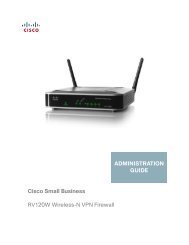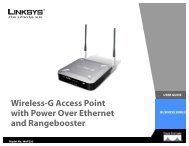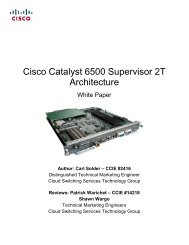Cisco EnergyWise IOS Configuration Guide - Ipland
Cisco EnergyWise IOS Configuration Guide - Ipland
Cisco EnergyWise IOS Configuration Guide - Ipland
You also want an ePaper? Increase the reach of your titles
YUMPU automatically turns print PDFs into web optimized ePapers that Google loves.
Chapter 2<br />
Configuring <strong>EnergyWise</strong><br />
Manually Managing Power<br />
Step 4<br />
Command<br />
Purpose<br />
energywise keywords word,word,... Assigns at least one keyword for the port.<br />
When assigning multiple keywords, separate the keywords with commas, and<br />
do not use spaces between keywords.<br />
• You can enter alphanumeric characters and symbols such as #, (, $, !, and<br />
&.<br />
• Do not enter an asterisk (*) or a space between the characters or symbols<br />
By default, keywords are not defined.<br />
Step 5 energywise name name Specifies the <strong>EnergyWise</strong>-specific port name.<br />
• You can enter alphanumeric characters and symbols such as #, (, $, !, and<br />
&.<br />
• Do not enter an asterisk (*) or a space between the characters or symbols.<br />
The default is a short version of the port name; for example, Gi1.0.2 for<br />
Gigabit Ethernet 1/0/2.<br />
Step 6 energywise role role Specifies the role of the port in the domain, such as lobbyport.<br />
Step 7<br />
• You can enter alphanumeric characters and symbols such as #, (, $, !, and<br />
&.<br />
• Do not enter an asterisk (*) or a space between the characters or symbols.<br />
By default, the role is interface.<br />
(Optional) Before entering the energywise activitycheck command<br />
• Verify that auto quality of service (auto-QoS) is enabled on the port and<br />
on the connected IP phone.<br />
• If the domain member is connected to the IP phones through multiple<br />
<strong>Cisco</strong> devices, verify that they trust the CoS value in incoming packets.<br />
To configure auto-QoS, see the “Using Activity Check” section on page 2-12<br />
and the software documentation for your <strong>Cisco</strong> network device.<br />
Step 8 energywise activitycheck Verifies that the connected IP phone is not sending or receiving traffic before<br />
the domain member powers off the port.<br />
Note The domain member cannot determine if the IP phone is in the hold<br />
state.<br />
Step 9 energywise allow query set If the interface receives a query from the management station or another<br />
domain member, configures the interface to respond to a query changing the<br />
power level and the <strong>EnergyWise</strong> attributes.<br />
By default, the domain member responds to this query.<br />
Step 10 end Returns to privileged EXEC mode.<br />
Step 11 show running-config Verifies your entries.<br />
Step 12<br />
copy running-config<br />
startup-config<br />
(Optional) Saves your entries in the configuration file.<br />
OL-19806-04<br />
<strong>Cisco</strong> <strong>EnergyWise</strong> <strong>Configuration</strong> <strong>Guide</strong><br />
2-9

















